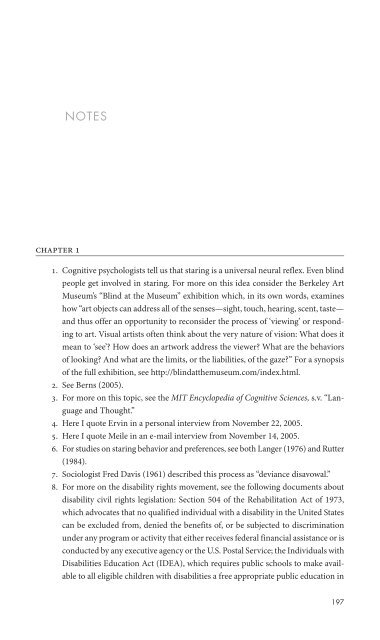Staring how we look sobre la mirada.pdf - artecolonial
Staring how we look sobre la mirada.pdf - artecolonial
Staring how we look sobre la mirada.pdf - artecolonial
Create successful ePaper yourself
Turn your PDF publications into a flip-book with our unique Google optimized e-Paper software.
94 STARERS AND STAREES<br />
greet him as “fellow Outsiders” (127). Before he used a wheelchair, women<br />
with whom he established eye contact would typically <strong>look</strong> away, but when<br />
he becomes disabled, women continue the eye contact, nod, or smile, which<br />
he interprets as “an opening of the self, an acknowledgment of the other,<br />
a meeting without closure” (127). Disability, he concludes, feminizes men,<br />
making them socially equal to women and people of color. This feminizing<br />
does not make Murphy feel further diminished, but rather seems to him an<br />
affirming recognition that gives him a new set of potential interpersonal<br />
re<strong>la</strong>tions within which he can develop a stronger sense of self. Murphy’s<br />
wheelchair dissolves his previous status, creating an opportunity for new<br />
re<strong>la</strong>tional equality.<br />
If an arc of empathy is to leap across the breach opened up by staring,<br />
persistence and generosity must prevail on both sides. Starees must insist<br />
on recognition as fellow humans by wielding an array of interpersonal techniques<br />
that the commonly embodied need not acquire. 5 One staree exp<strong>la</strong>ins<br />
this interactive process as an opportunity to “transform an uncomfortable<br />
and annoying inevitability into a positive reflection of myself as a example<br />
of a person with a disability who is a proud and functioning member of society”<br />
(anonymous, 2006 interview). She understands her role in the staring<br />
encounter as one of “defiance.” Her aim in that defiance is to “reflect back to<br />
them that (1) they are staring at someone, (2) that someone KNOWS they<br />
are staring at them, and (3) that person they are staring at is an amazing<br />
person. Then they walk on with something to think about . . . they MIGHT<br />
be thinking that . . . <strong>we</strong>’re not so different after all.” When this woman stares<br />
back—much like Shay<strong>la</strong>, the burn survivor who peers starkly at us out of her<br />
portrait—her returned stare is not a plea, but rather an assertive outreach<br />
toward mutual recognition across difference. The returned stare from the<br />
starees both on the street and in the portraits instructs the wide-eyed that<br />
they are amazed by an “amazing person.” The starer—whether stunned, tentative,<br />
or hostile—responds to the staree, who guides her visual interlocutor<br />
toward the self-representation of her choice. An amazing person, the eyes<br />
exp<strong>la</strong>in, is what you see.


